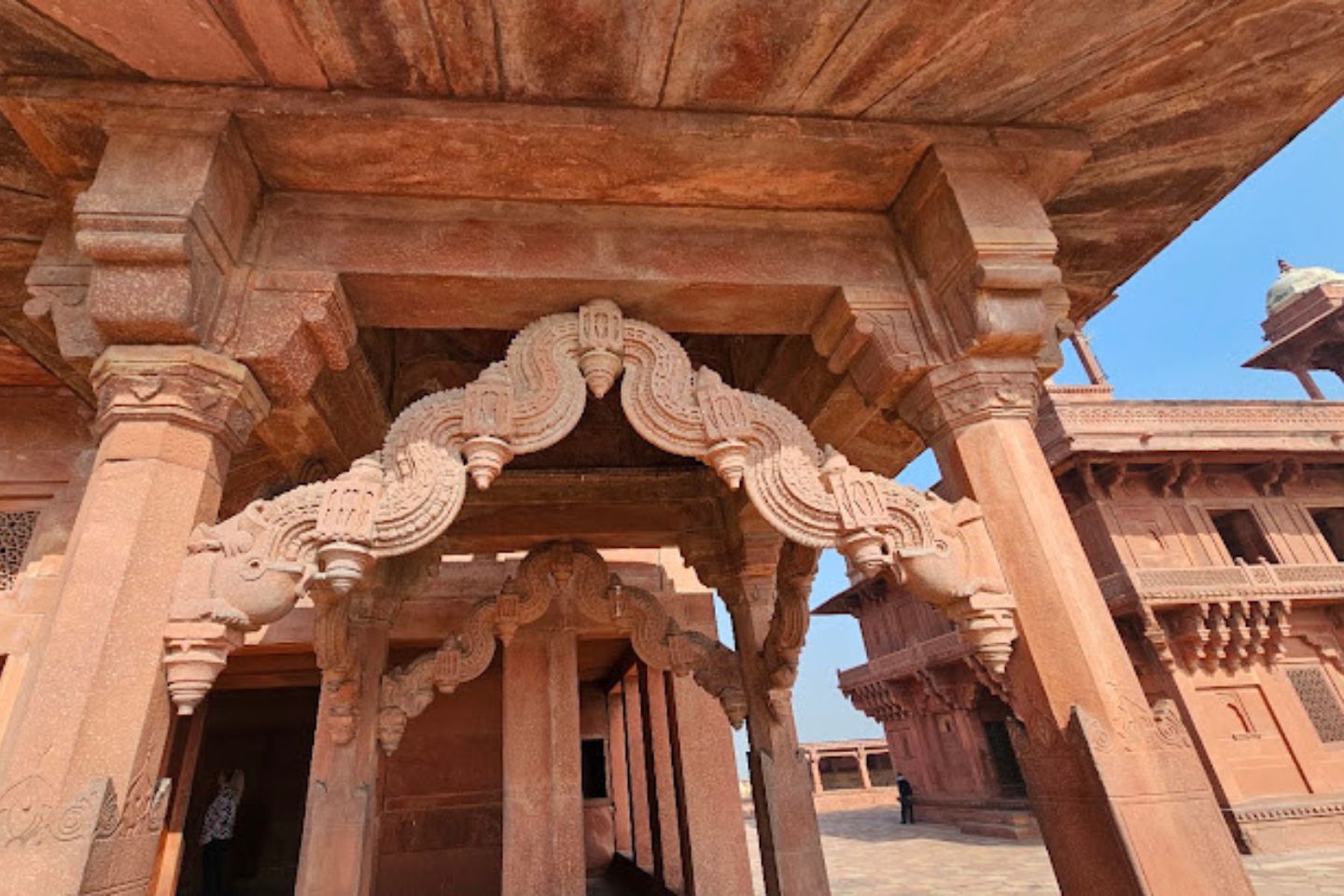Lotus Throne Fatehpur Sikri Entry Fee
- 50 per person for Indians
- 50 per person for citizens of SAARC and BIMSTEC countries
- 610 per person for other Foreign nationals
Lotus Throne Fatehpur Sikri Phone
N/A
Rating:  | 4/5 stars
| 4/5 stars
Based on total 29 reviews
Lotus Throne Fatehpur Sikri Agra Address: Dadupura, Fatehpur Sikri, Uttar Pradesh, 283110, India
Agra Tour Packages
Agra Tour PackagesLotus Throne Fatehpur Sikri Timings
| Day | Timing |
|---|---|
| Monday | 6:00 am – 6:00 pm |
| Tuesday | 6:00 am – 6:00 pm |
| Wednesday | 6:00 am – 6:00 pm |
| Thursday | 6:00 am – 6:00 pm |
| Friday | 6:00 am – 6:00 pm |
| Saturday | 6:00 am – 6:00 pm |
| Sunday | 6:00 am – 6:00 pm |
Note: Lotus Throne is open from sunrise to sunset
Links: Website | MapWhen you think of Agra, there is possibly only one monument that comes to mind - Taj Mahal. The beauty and elegance is timeless. But is that the only monument that defines the existence of this place?
No.
How about going beyond the city limits?
Welcome to Fatehpur Sikri.
Located near Agra, it boasts a rich historical background with numerous monuments, making it a renowned destination for tourists worldwide.
The town features a fort showcasing numerous structures that serve as a testament to the grandeur of Mughal architecture.
Among its many splendours lies the Lotus Throne, a stunning architectural marvel in the Diwan-e-Khaas, also known as the Hall of Private Audience in the Fatehpur Sikri Fort.
So, if you are in Agra, a short drive to Fatehpur Sikri to take in the beauty of this enchanting monument is a must for all.
Gallery of Lotus Throne, Fatehpur Sikri
All about Lotus Throne, Fatehpur Sikri
The Diwan-e-Khaas, or the Hall of Private Audience, is a majestic building within the Fatehpur Sikri Fort.
Akbar greatly respected every religion and actively sought to learn about faiths beyond Islam. Consequently, he occasionally permitted scholars from various religions to visit Diwan-e-Khaas and discuss religious matters.
Additionally, Akbar and his esteemed council, known as the "nine gems," utilised the hall to discuss state affairs.
Entering the magnificent interiors of Diwan-e-Khaas unveils beautiful red stone pillars embellished with elaborate carvings.
The Lotus Throne, the central pillar of all, served as the support for Akbar's throne.
Linked to this central column were four additional pillars at the corners, connected by a pathway. These pillars also featured platforms where scholars of various religions gathered for discussions.
Initially, it was used for religious discussions, but later, it was dismissed as it had narrow galleries. Then, it was believed to have been used for housing jewels and gems of the sultanate.
History of Lotus Throne, Fatehpur Sikri
The Lotus Throne's history intertwines with the reign of Emperor Akbar, a visionary Mughal ruler. With Diwan-e-Khaas serving as the central chamber for royal deliberations, the Lotus Throne bore witness to significant moments in Mughal history.
Adding to the mystique, it is said to be where Akbar announced the "Deen-e-Ilahi", a syncretic religion or sect to consider all religions and sects as one.
Architecture of Lotus Throne, Fatehpur Sikri
As travellers explore the intricate carvings and the imposing presence of the Lotus Throne Pillar, they become part of a rich tapestry that unfolds the legacy of Akbar's rule.
The lotus-inspired design of the throne symbolises purity and divinity, adding a spiritual touch to this architectural masterpiece.
Serving as the central platform of the Diwan-e-Khaas, the Lotus Throne is a singular red stone pillar standing 6 metres high from the ground.
It is an impressive design with 36 arched and hanging brackets that uphold a raised circular area (the throne).
The pillar's shaft is its most beautiful feature as it is constructed in panels or blocks, each with a unique design - starting from Jain architecture and moving down to Buddhist, Christian, Islamic, and Hindu designs.
Entry fee and timings of Lotus Throne, Fatehpur Sikri
There is no separate entry fee for Diwan-e-Khaas, though you have to pay a nominal fee to enter the Fatehpur Sikri Fort - Rs 50 for Indians and Rs 610 for foreign tourists.
Children below 5 years of age are exempt from entry fees.
The fort is generally open from sunrise to sunset, allowing ample exploration.
Best time to visit Lotus Throne, Fatehpur Sikri
The best time to visit Fatehpur Sikri is during the winter months, from October to March when the weather is more pleasant and suitable for exploring the historical site.
How to reach Lotus Throne, Fatehpur Sikri?
Situated 37 km from Agra in Uttar Pradesh, the fort is easily accessible by road, rail, and air. Once you are in Agra via any commute, a short drive will take you to Fatehpur Sikri.
By road: Frequent buses are available from Agra to Fatehpur Sikri. You can choose the one that suits your time and reach here.
By Rail: The nearest railway station to Fatehpur Sikri is in Agra Cantt, and from there, you can hire a cab or take a bus to Fatehpur Sikri.
By Air: The nearest airport is Pandit Deen Dayal Upadhyay Airport, which is well-connected to major cities in India. From the airport, travellers can hire a cab to reach Fatehpur Sikri.
As you explore the Lotus Throne at Fatehpur Sikri, a mix of history, architecture, and cultural opulence awaits.
The Lotus Throne Pillar silently bears witness to history, urging travellers to experience the magnificence of Mughal heritage.
If this piques your interest, wait until you encounter this magnificent structure on your trip to Fatehpur Sikri. Explore the beautiful city of Agra by booking a Agra Tour Packages with us. At Agra Tourism, we offer customised tours to suit your budget and other interests. To know more about our offerings, please fill the Contact Us form.





